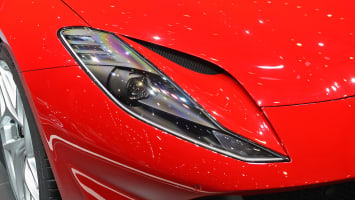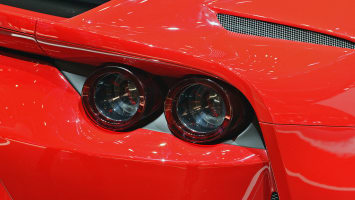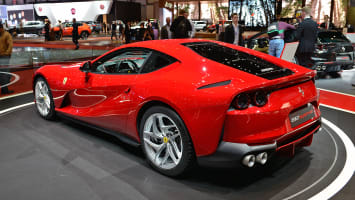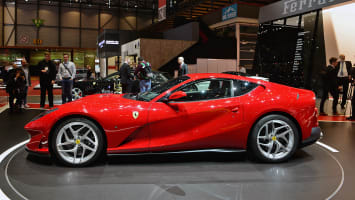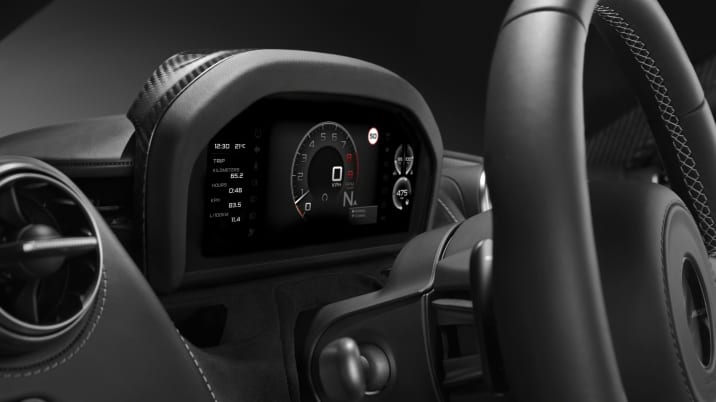“Well, they’re very committed and passionate,” that’s how a spokesman described McLaren’s engineering team. Trouble is, English passion tends to be marked by a raised eyebrow, Elgar’s understated Nimrod, and elegant motorcars finished in midnight blue. Italy trumps that with arms flung wide, Rossini’s operas, and blood-red cars howling down the endless straights of Emilia-Romagna.
Perhaps that’s the problem for McLaren, which seems to have so far built cars appreciated by race drivers and finicky poindexters, rather than those who like a Ferrari, Lamborghini, or a Maserati because of the shape, the style, the passion, and the operatic exhaust noise.
Geography doesn’t help (nor do engines that sound like leaf blowers). Woking in Surrey was never going to roll off the tongue quite like Sant’ Agata, Bolognese, or Maranello. All this might be about to change this afternoon, however, with the launch of the second-generation of the Super Series car, the 720S, at the Geneva Motor Show.
Super Series is the middle of a hierarchy of three similar McLaren car ranges: all mid-engined with carbon-fiber tubs sharing similar hard points for the aluminum, carbon-fiber, and Sheet-Moulded-Composite (SMC) coachwork and sharing the same Ricardo-built V8 bi-turbo and seven-speed twin-clutch transmission driving the rear wheels. Known as ‘entry, core and high’ by engineers, it starts in the Sports Series, runs through Super and into Ultimate. (Of which there has only been one example, the 2013 P1, although the new “Hyper GT” is promised in 2019.)
These cars are largely based on McLaren Automotive’s inaugural car, the 2011 MP4-12C. But the 720S marks a new generation and is claimed to be 90 percent all-new.
The more it changes, the more it stays the same, wrote novelist Jean-Baptiste Karr, whose 19th-century musing applies to the 21st-century McLaren. Stuff that’s essentially the same: The carbon-fiber tub, though it trades the predecessor 650S‘s aluminum superstructure for carbon fiber. The engine is the familiar Shoreham-made, 90-degree, quad-cam, dry-sump, twin-turbo, but it’s been stroked from 3.8 to 4.0 liters, with two Mitsubishi Heavy Industries twin-scroll turbochargers, similar in concept to those used in the P1. These should be capable of providing more boost lower down the rev range, answering criticisms of the old car being too peaky. Haydn Baker, vehicle line director for the Super Series, reckons the new car even sounds better than its much criticized predecessors.
Peak power rises from the 650S model’s 641 horsepower to 710 at 7,250 rpm, and peak torque goes up from 500 pound feet to 568, though we’re not told at what revs this occurs. Carbon-dioxide emissions are down, which is often an indication of a slightly more flexible power unit.
Performance, never a weak spot for McLaren, has been improved for the 720S. Compared to the 650S coupe, the 0-62 mph time is down from 3.0 to 2.9 seconds, 0-124 mph is down from 8.4 to 7.8 seconds, and 0-186 mph (should your state’s authorities deem it legal) is reduced from 25.4 to 21.4 seconds. Top speed increases from 207 to 212 mph, and the standing quarter-mile time is down from 10.5 to 10.3 seconds.
Weight has been shed, too, down 40 pounds from the 650S to 2,829 pounds dry and 3,128 fueled. Not explicitly stated is the extent of what is called ‘all-new geometry’ for the new lighter aluminum upper and lower wishbone suspension. “I wanted to tell you, but they wouldn’t let me,” says Baker.
Pirelli P Zero tires are wider at the front (245/35/ZR19), but with slightly smaller carbo-ceramic brake rotors inside and AP Racing six-pot calipers. At the rear, the tires are 305/30/ZR19 Pirellis with a slightly wider track.
The 720S looks different, yet has visual links to all the other McLarens. There’s a perception of a low-drag Le Mans-style tail and that lower front looks mighty vulnerable to high curbs. The roof seems more rounded, and that double curvature on the rear wheel arch looks like a nasty bruise picked up on a football field. Otherwise, there’s a disarming lack of adornment when seen from the sides, and you start to wonder how they have contrived to cool the big V8 behind the seats.
Move toward the front or back, though, and the air channels become visible, running like Roman aquifers along the tops of the doors and into the rear wings and the high-temperature radiators. It’s a clever design device, as are the ‘socket’ headlamps, which draw oncoming air into another set of low-temperature radiators on each side of the front.
The coachwork apparently achieves its target of doubled aerodynamic efficiency by combining coefficient of drag, downforce, and lap times. Just as important, however, is the space around the underbody hard points the engineering team gave design chief Rob Melville, which has allowed him to create a shape, that while recognizably a McLaren, is also interesting and attractive, if not conventionally beautiful. What’s more, the whole vehicle was designed and mostly engineered on computers, with not a single experimental prototype constructed, though Baker admits, “we did have 20 prototypes as a test fleet.”
In the cabin, there’s a perception of more space in spite of a width reduction. This feeling can be partly explained by the narrow roof spars, particularly the bare carbon-fiber windscreen pillars. With roof lights in the doors and sectioned windows in the rear, the cockpit feels more like sitting in a World War II fighter aircraft, or an Elizabethan house. There’s even a bit of luggage space behind the seats, but since the tailgate doesn’t open, you’ll have to wrestle those airline carry-ons past the seats and under the roof. Getting into the cockpit, however, is a lot easier, with roof cut-outs for the scissor doors just like the original Ford GT40s.
McLaren claims the new 720S will offer most of the track credibility and lap speed of the outgoing 675LT, but with road manners akin to the Sports Series 570GT hatchback. That seems to be key as this small but profitable firm gets more comfortable in its skin. McLaren cars have so far offered highly centered track performance, but road presence, exhaust noise and low-down torque haven’t been as peerless. While undoubtedly faster than its predecessor, the 720S is attempting to close a more subtle gap with the opposition. “Those road manners were very dear to my heart,” says Baker. “We’ve debated this car for over four years and put a lot of work into it.”
No prices yet, but expect an increase on the $265,500 price of the 650S. It remains to be seen whether McLaren’s second-gen Super Series will rattle the breakfast tables in Maranello, but the first signs are promising.
Related Video:

